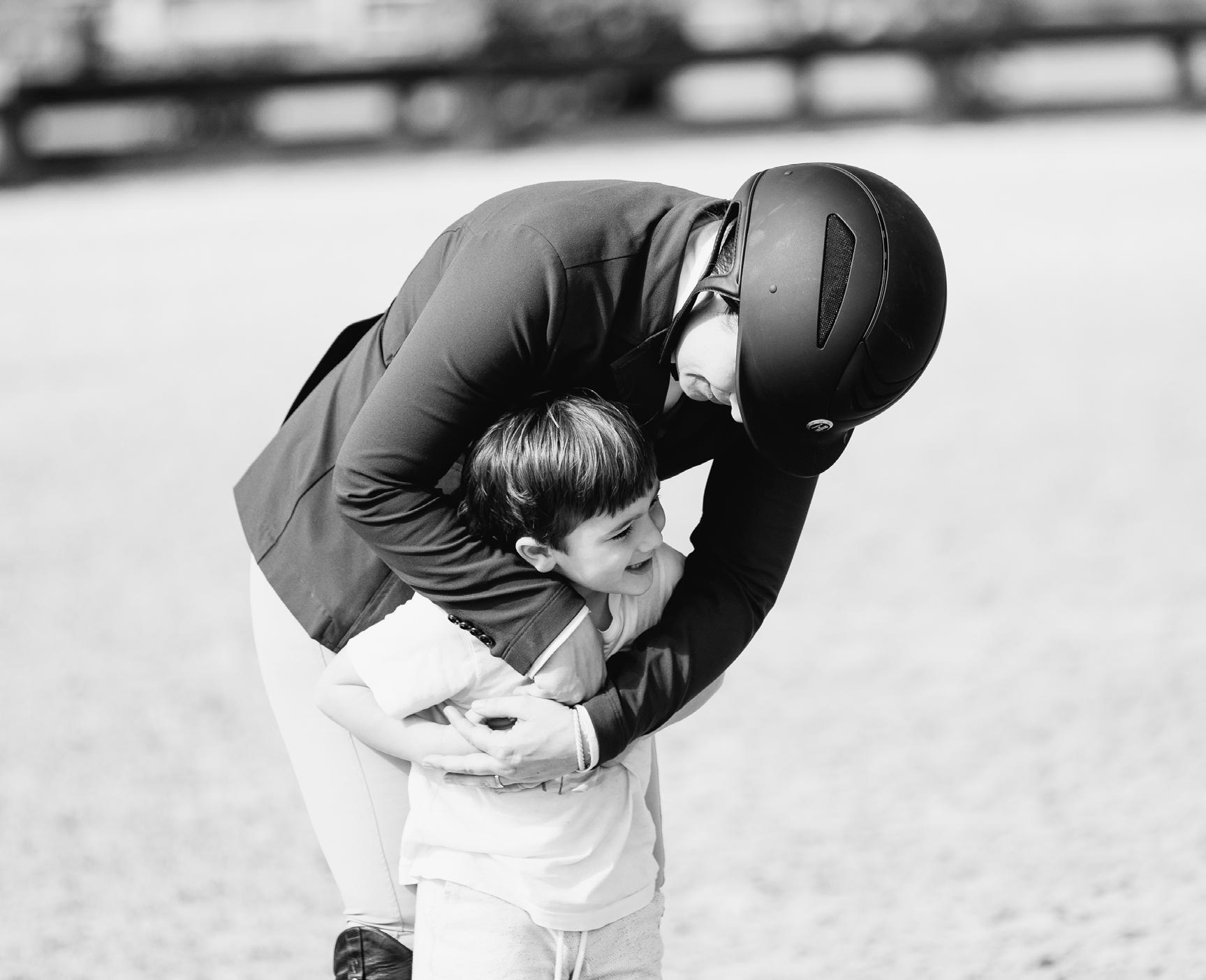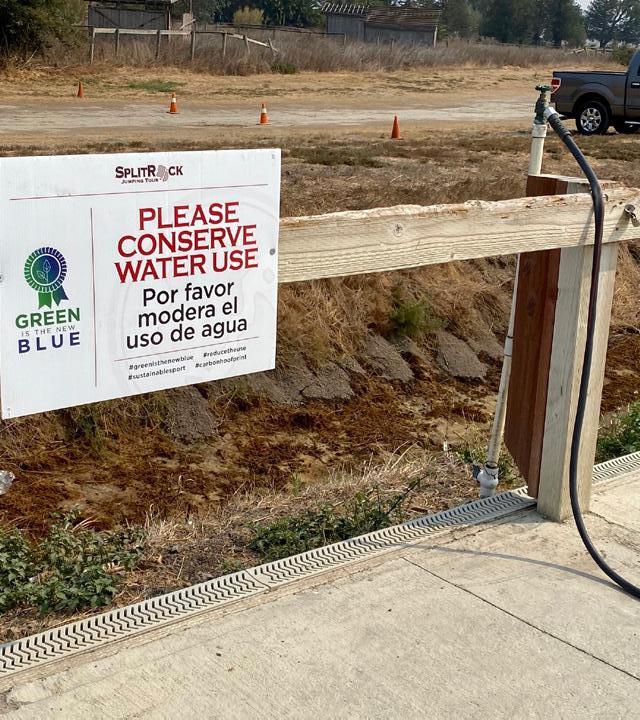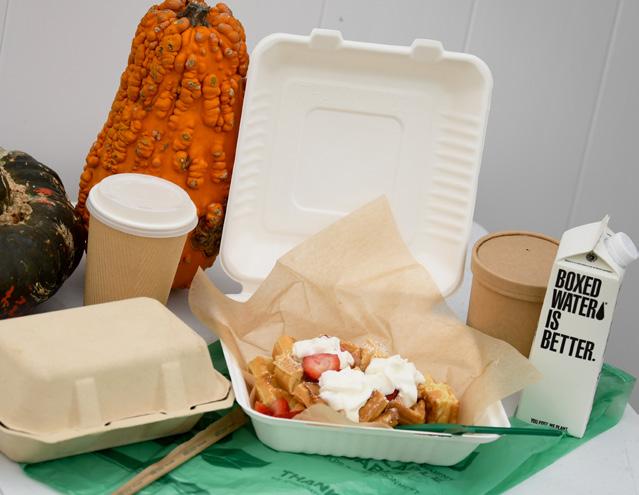
10 minute read
GREEN LIFESTYLE
by Erin Gouveia
GREEN IS THE NEW BLUE
Why is Stephanie Bulger of Green Is The New Blue dedicated to making horse shows and equestrians more environmentally responsible? “Having my son in 2015 really cemented in me the urgency to protect the planet. It feels daunting a lot of the time, which is why I chose to focus on what was in my immediate surroundings; my home, my lifestyle, and my sport.” Bulger founded the environmental non-profit less than two years ago and the response has been overwhelmingly positive so far!
Horse & Style: Tell us a little about your background and your love for horses.
Stephanie Bulger: I grew up in New York City, far from horse country. But I think loving horses was in my destiny because I was always drawn to them and desperately wanted to be around them from the time I can remember. My mom found a stable near our summer home in Long Island, NY, and I started taking weekly lessons at age five. That turned into several days a week, then pony camp, then short stirrup, and, 30-ish years later, here we are today.
H&S: When did you realize you wanted to make environmental issues and a green lifestyle a priority?
SB: Having my son in 2015 really cemented in me the urgency to protect the planet and do anything I could to change the outlook for him and those who come after him. It feels daunting a lot of the time, which is why I chose to focus on what was in my immediate surroundings: my home, my lifestyle, and my sport.

GITNB founder, Stephanie Bulger with her son, photo © Giana Terranova
H&S: Why did you start GITNB?
SB: I started GITNB because I saw the need for it. I realized that no one was out there focusing on the environmental impact of horse sports, so rather than just complain about it, I decided to take action. In the equestrian space there is not often a choice between a “green” option and a conventional option. Put it this way, if you were environmentally minded and loved coffee, you might choose a coffee shop that used organic and ethically sourced coffee beans, compostable cups, solar energy, and refused single use plastics, over one that did not. Horse people do not have these options because environmentally friendly horse shows and products simply do not exist. There is no competition in the market to inspire positive change.
H&S: A big focus for GITNB are horse shows. What are some negative impacts that horse shows have on our environment?
SB: The immense volume of single use plastic waste is staggering. From shavings bags, feed bags, medication tubes, baling twine, not to mention all the garbage that people generate, there is a tremendous amount of trash that horse shows produce. Manure and shavings disposal is another big problem. Many people think that since it’s “natural” it will somehow magically biodegrade, but that’s simply not true. Those byproducts create a ton of methane gas. There is also the problem of water used to maintain grass or irrigate show rings.
H&S: How can horse shows decrease these impacts and put sustainability practices to work?
SB: Horse shows can start with one area and make small changes. Whether it’s rain water collection, investing in proper composting facilities, making sure there are plenty of recycling bins, providing refillable water stations and encouraging vendors to go plastic free, there are a ton of baby steps horse shows can take. Managers can also use their clout to encourage businesses – feed companies, supplement and medication manufacturers, jump builders, for example – to change their packaging. In the US, the burden of disposal lies on the consumer, not the manufacturer. So unless we the consumer put pressure on the manufacturer to change their packaging, it’s not going to happen.

GITNB reminders to conserve water at the wash racks on the Split Rock Jumping Tour

Biodegradable and compostable to-go products; photo © Split Rock Jumping Tour
H&S: What are your green initiatives?
SB: We have several that I am proud of and excited about. For one, I believe the younger generation – the Greta Thunbergs of the world – are the real game changers. We partnered with CPI, or the College Preparatory Invitational, and created an environmental essay contest, an environmental stewardship challenge, and a scholarship for a collegiate equestrian who is planning on studying environmental science. We have several prominent horse shows taking the “refuse to use” pledge, and banning single use plastic packaging. At the Aiken Horse Shows the food vendors switched to entirely biodegradable and compostable to-go products, including straws that are 100% marine biodegradable and styrofoam that is landfill biodegradable. At the Desert Horse Park as well as the Split Rock Jumping Tour shows, we provided reusable water bottles and had hydration stations all around the show for riders, trainers, grooms, and support staff to refill. COVID-19 has made this challenging, of course, so for now we are providing free boxed water. It’s not a perfect solution, but it is the best we can do right now in the midst of the pandemic.
H&S: Who are some of your partners today?
SB: We have relationships with: Split Rock Jumping Tour, College Preparatory Invitational, The Washington International Horse Show, The Desert Horse Park, The Aiken Horse Park, The Pennsylvania National Horse Show, Ludwig’s Corner Horse Show, Endeavor Therapeutic Riding, Brandywine Horse Show Series, The Upperville Colt and Horse Show, Palm Beach Masters, the Gleneayre Equestrian Program, with more coming on board all the time.
Please visit our website at greenisthenewblue.org and click on the “Green Partners” tab to find out more about becoming a GITNB partner.
H&S: What can a new partner expect when working with GITNB?
SB: We will work together to identify specific goals for that show, especially the logistical ins and outs of the venue. For instance, when we worked with Washington, we had to be cognizant of the limitations of the Verizon Center itself which handles most of the horse show infrastructure.

FloWater water bottle refilling station
H&S: How has GITNB grown and changed over time? What results has your organization achieved so far?
SB: Green Is the New Blue is still relatively young, so we are evolving every day. The biggest and best change so far has been building our team from my doing everything myself to having an amazing group of people working together on our shared goal. We have a creative director, Scot Evans, a marketing team headed by Michael Cruciotti, a wonderful intern named Anna Zygadlo, social media support by Emily Cleland, and a ton of incredible volunteers.
H&S: What have you learned on your journey since starting GITNB?
SB: I have learned how hungry the world is for this kind of change. The interest and curiosity about our work is inspiring. I love talking about these issues and hearing the questions, concerns and frustrations people have, as well as the ideas we brainstorm together.
H&S: What is the biggest challenge you’ve faced while trying to build GITNB?
SB: Mostly the misinformation that is out there about the state of environmental practices in this country as a whole. It has become a political issue, rather than an ethical one, and that saddens me. I hear from people that they are diligent recyclers at home, and they are shocked to find out that only about 9% of all plastic waste in this country actually gets recycled. That means if you put 10 plastic water bottles in your recycling bin, only one will actually be recycled. People also don’t understand that plastic can only be recycled once because the process denatures the molecular structure. A glass bottle can be recycled an infinite number of times, plastic only once. That is why we preach reduction rather than emphasizing recycling.
H&S: What are your short-term and long-term goals for GITNB?
SB: Our short and long term goals are similar: to enact change in the governing bodies of the sport so that green practices are required for competitions, not simply up to the competitions themselves to try and make them happen. Often green practices cost more money than conventional ones; if the federations supported them financially, it wouldn’t be cost prohibitive for shows to make the green choices.
H&S: Can you share some of your favorite green products that will help readers practice a more environmentally conscious lifestyle?
SB: We love Go Pure Pods (gopurepod. com) water filters. They are tiny, last for six months, and purify ANY water in about 30 minutes, even water from a garden hose. They have saved me from getting desperately thirsty and reaching for a plastic bottle when I can’t find a place to refill my reusable bottle.
I also have been giving Cora Dryer Balls (coraball.com) out as gifts. They catch the tiny micro plastics from our clothes – especially synthetic fabrics – and prevent them from going into the water stream. The ball just lives in your dryer, and needs to be shaken out over the trash to clear the little bits of plastic once in a while. These micro plastics are eaten by the smallest animals in our marine food chain, that is why they are so dangerous. Cora balls are great for the barn as well, as they catch the micro plastics in polo wraps, bandages, saddle pads, and blankets.
For Christmas my husband gave me a Vitamix Food Cycler (vitamix.com). Some people ask for jewelry, some want a composting machine! It has drastically helped cut down our food waste by turning kitchen scraps into compost in a matter of hours. It only takes up one cubic foot of counter space and is super user friendly. It was an investment, but a valuable one.
You will notice I don’t have many suggestions for equine products because there sadly aren’t that many. We do love Oaklyn girths (oaklyntack.com) which are made from recycled water bottles. It’s a women-owned and operated business and we are big fans of the girths. They look and perform great.
H&S: What are some green practices that we can begin to practice in our daily lives at home and at the barn?
SB: I have noticed that people have really caught on to bringing their own bags to grocery stores – and that’s great! What hasn’t caught on yet are reusable produce bags. People are still reaching for the flimsy plastic ones. I suggest investing in a handful of canvas or mesh ones. They are vastly better for the earth and keep your produce fresher which saves money in the long run.
I wish that single use coffee and tea pods would go away forever. They are such a scourge on the planet and I think the product tastes gross too! They sure are convenient though, so find a way to streamline your morning beverage routine to make it faster. My husband and I set up our coffee maker the night before so all we have to do is push the button and we have coffee in less than five minutes. When I know I am going to have a rushed morning I even put oat milk in my to-go mug and leave it in the fridge so I can make coffee with my eyes closed.
I also suggest keeping some utensils and cloth napkins or even old bandanas in your car, purse, backpack, tack trunk, or barn kitchen so if you do have to grab lunch to go, you don’t have to use plastic ware, which is not recyclable. I am not perfect, when I have an early class at the show I often don’t have time to pack a lunch for myself between making my son breakfast, getting his lunch ready, feeding myself breakfast, oh and taking care of the dog and bunny! So on those occasions when I do have to get something to go, I know I have real silverware and a napkin ready so I don’t have to rely on plastic.
H&S: Anything else you’d like to share with our readers about GITNB?
SB: I am overwhelmed by the positive support and interest in our work. I encourage people to reach out, check us out online or on our socials, and join the conversation. It feels so good to make positive changes in the horse world that I love so much.

GITNB living jump; photo © A&S










